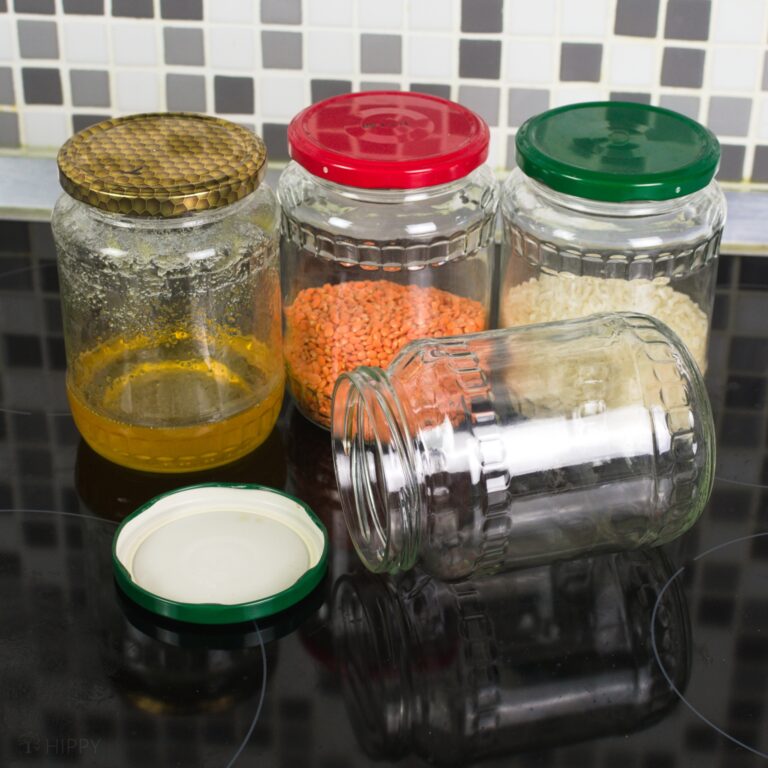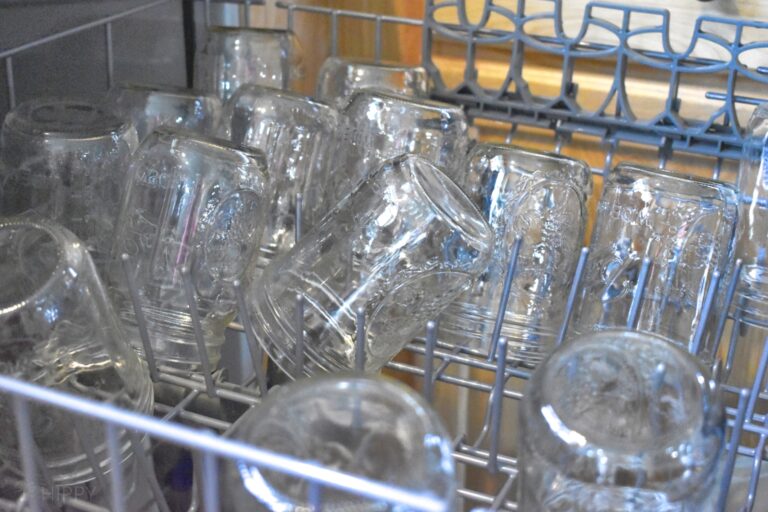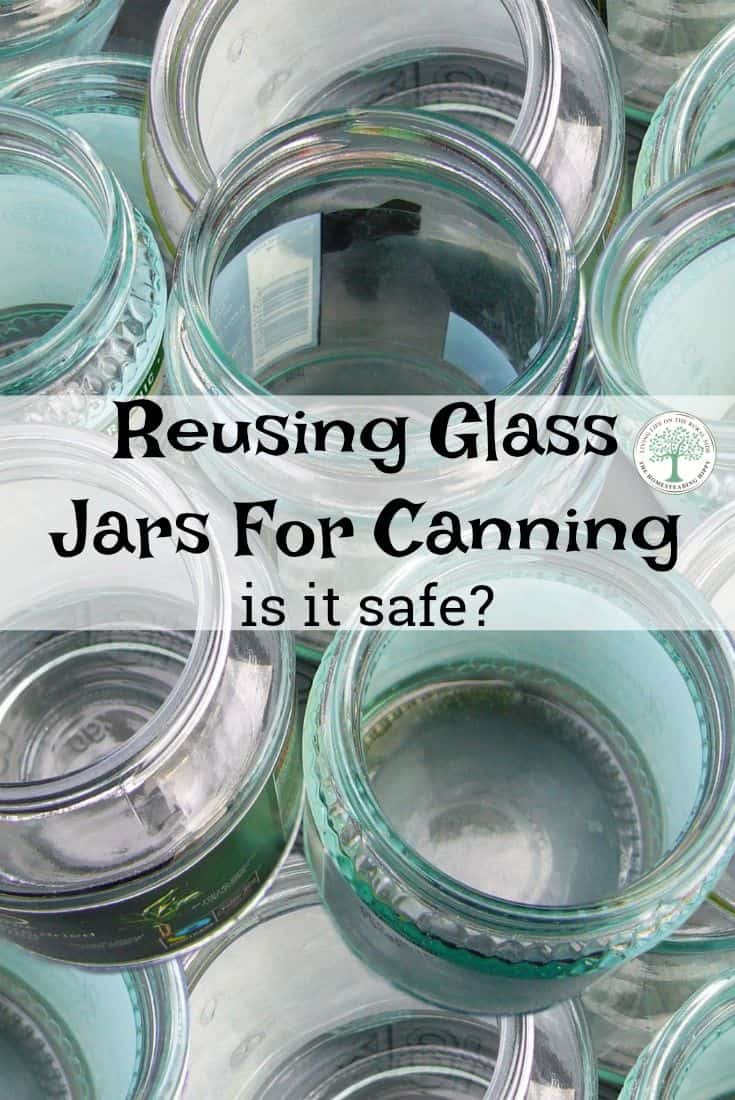Canning is a great way to save your garden produce. It’s made to be shelf stable, so you can store it on the pantry shelf, saving you plenty of freezer or fridge space.

But there are certain mistakes newbie canners make – and this is one of them.
No, you shouldn’t use any glass jar you have available for canning, whether spaghetti, mayonnaise, or pickle jars. Some are usable but it’s risky. Get actual canning jars instead.
The Problem With Reusing These Glass
You might feel tempted to reuse glass (or even plastic) jars that were leftover from items you bought at the store. However, there are two characteristics that a good canning jar must have.
It must have tempered glass, which will allow the glass to withstand higher temperatures. It also needs to have a secure seal, either with a rubber seal or gasket or a seal that’s built into the canning lid.
You may be wondering how stores can sell “canned” or “processed” goods in jars that are not your typical canning jars.
The reason is simple.
Food contents of store-bought jars are processed using industrial machinery and manufacturing processes that are far more advanced than what you can do in a home kitchen.
When you bought the food from the store, it was perfectly safe to eat – but you won’t likely be able to can your own contents in the same way. Yes, even if you use a new lid!
Specialty preserving jars are made with tempered glass, reducing the likelihood that the jar will break during processing.
Why would you want to reuse a store-bought jar, only to run the risk of it breaking inside the canner? Or worse, injuring yourself when the jar explodes?
Some people argue that you can determine whether a reused jar is safe for canning by sterilizing it in the canner and then inspecting it carefully for chips and cracks.
If the jars can withstand the heat, they will probably hold up fine in the canner – or so the theory goes. However, the problem with this is that minuscule, practically invisible cracks are often present that can seriously damage the contents of your food.
The bottom line is that when you reuse jars, you have an increased likelihood of seal failures, jar breakage, and spoilage.
Even the Experts Don’t Agree
There are lots of jars to be found at thrift stores, yard sales, and more to get you started. There are jars from spaghetti sauce, peanut butter, and even mayo that are just waiting to be filled with garden goodness.
But, is the practice of reusing glass bottles safe to use for canning? Can you reuse store-bought jars for canning?
That depends on which camp you belong to. Some say “absolutely not,” and some say “sure, why not, reusing jars is completely safe.”
According to the National Center For Home Canning,
Most commercial pint- and quart-size mayonnaise or salad dressing jars may be used with new two-piece lids for canning acid foods. However, you should expect more seal failures and jar breakage. […]
These jars have a narrower sealing surface and are tempered less than Mason jars, and may be weakened by repeated contact with metal spoons or knives used in dispensing mayonnaise or salad dressing. Seemingly insignificant scratches in glass may cause cracking and breakage while processing jars in a canner.
Mayonnaise-type jars are not recommended for use with foods to be processed in a pressure canner because of excessive jar breakage. Other commercial jars with mouths that cannot be sealed with two-piece canning lids are not recommended for use in canning any food at home.
National Center For Home Canning
So in short:
- don’t reuse mayonnaise jars for canning
- don’t reuse salad dressing jars
- don’t use commercial wide-mouth jars that cannot be sealed (such as pickle jars)
It’s Okay to Reuse Some Jars
So, you CAN reuse some spaghetti sauce jars, some mayo jars or peanut butter jars with little issue. But since you can’t be sure which will last and which won’t, it’s probably best to avoid all of them.
Best practice is to make sure they are very clean and sterilized. The lid and band will need to fit snugly on the top of the jar as well.
If you notice any cracks, toss the jar and do not reuse. Small cracks can cause the jar to become weaker and break. They just are not suitable for pressure canning.
During World War Two, the USDA actually encouraged people to reuse jars from store-bought (spaghetti sauce, mayo, etc.) to home can garden produce with. This was due to the wartime shortage of glass. This was a common practice for many households for years.
When Old Canning Jars are Not Safe
Are there times when recycled mayo, spaghetti sauce, or peanut butter jars are NOT safe? Sure. The quart-sized mayo jars that many say “My Grandma reused these with no problems” are not designed to withstand the heating and reheating that comes with home canning food safely.
They also have a more narrow sealing surface, and the lid may not properly seal out air, bacteria, and such. An improper seal will cause loss of food and possible bacteria build-up that you DON’T want.
The advice for reusing store-bought jars is actually no longer USDA-recommended for home canning, and Nancy Hudson, a former extension agent in Greene County, Ohio, explained the reason for the recommendation as far back as 1986:
As of 1987, USDA will be recommending the use of one way jars such as instant coffee or mayonnaise jars to be used in a hot water bath canner only if the family has no other alternative However, these jars will not seal with the zinc lids and rubber rings….
With one way jars, the glass is thinner and will take a heat shock of only 75 F degrees. If the jar is at room temperature (70 F degrees) and the food is at 145 F degrees, you will have no breakage. However, with a one way jar at room temperature and the food at 190 F degrees, the jar will break.”
According to the National Center for Home Food Preservation:
Never use commercial jars such as mayonnaise and pickle jars for home canning. These jars are not very resistant to temperature extremes; they break easily.
Also, lids may not seal on these jars because their sealing edge is rounded rather than flat. Finally, the neck of the jar may be so short that the screw band will not hold the lid firmly in place during processing.
National Center for Home Food Preservation
What does This Mean?
Do you need to throw away all your old jars that are from store-bought products? I have a bunch of old mayo-style quart jars that my home-canned peaches look simply lovely in…
Many people like to reuse glass jars for canning simply for lifestyle choices. Some are doing it because of limited funds to purchase the “real” canning jars. As always, you are free to make your own choice here.
When in doubt about the jar, err on the side of caution and safety. Reusing glass jars for food storage such as oats, rice, and dried beans may be a much better idea for some.
No matter what anyone tells you, it’s really not recommended that you reuse jars of any kind if you plan on relying on canning to do the sterilization and processing.
Even if your grandmother, aunt, or friend down the street did it and never got sick, that doesn’t mean that you won’t, either. Botulism is not worth it!
What About Lids and Bands?
You might be tempted to further cut costs by reusing bans or lids. However, not all are reusable. In most cases, the cover for a can consists of two pieces –a seal (the flat metal lid) and a screw band (the ring or band).
The gaskets in unused lids can work for at least five years, but it is not recommended that you use seals more than once.
If you do, you’re playing with fire. The compounds will have softened and reshaped, and you could potentially not get an airtight connection.
The band, on the other hand, can be used again and again until it starts to rust.
There are some companies that have begun to manufacture reusable canning seals. The jury’s still out on whether these are safe, so use your best judgment.
However, these consist of separate screw bands, reusable lids, and gaskets – they’re three-piece instead of two-piece units.

Rules to Remember Before Reusing Glass Jars
If you choose to reuse jars from store-bought products and wonder if it’s really safe, just remember:
- No commercial product maker is going to endorse their jars for re-use in home canning, ever. There are too many risks with broken jars and loss of food for them to suggest it.
- Be aware that there is a higher risk of breakage of reused jars.
- Most experts advise avoiding such jars in pressure canning, if possible.
- The rims of reused jars are commonly just a bit thinner than the rims of certified Mason jars, making it harder for the rubber gaskets on the undersides of the lids to get something to grip onto and make a strong, lasting seal.
- Before you re-use a jar for the first time, test to make sure that your two-piece lids fit first before filling it up, and verify that the gasket sealing compound fits out to the edges of the rim of the jar.
Another thing to keep in mind is the size of the jar. Jars of different sizes require different processing times – for instance, large jars take longer for ideal heat penetration.
Therefore, you should always use the size listed in the recipe. You can go down and process at the same time, but not up.
If you plan on freezing your goods instead of canning them, you won’t necessarily have to worry about food sanitation issues if you use the wrong kinds of jars.
However, you do need to be concerned about using jars that are not freezer-safe. Despite what most people think, not all wide-mouth jars are suitable for the freezer.
To get a good idea of whether your re-used jar is freezer-safe, look at the neck. If it looks like it has shoulders, like a human, under the neck (this is the area where you secure the band), then it is not freezer-safe.
It won’t necessarily make you sick, but it could cause cracking and breakage in the freezer.
Just Buy New Jars
The good news is that most canning jars are inexpensive, and can be reused for many, many years.
Regardless of whether you buy them new or you purchase them secondhand (you can often find them free at auctions, yard sales, or on auction sites like Craigslist!) they shouldn’t break the bank. Feel free to save your lids between canning batches, too.
Plus, you can repurpose your old jars or store-bought containers for other things, like:
- Holding nuts, bolts, screws, and other pieces of hardware
- Storing dry pasta, cereal, or beans
- Marinating meat
- DIY candles
- Indoor herb gardens
Do you reuse your store-bought glass jars for canning or do you avoid them completely? Be sure to pin this for later!


Heather’s homesteading journey started in 2006, with baby steps: first, she got a few raised beds, some chickens, and rabbits. Over the years, she amassed a wealth of homesteading knowledge, knowledge that you can find in the articles of this blog.
Learn more about Heather and the rest of the writers on this page.

I’m glad to see this article. I belong to an English group that even reuse the lids from store bought foods. Their whole process of canning is scary. Not wiping the rims, not processing, not sterilizing the jars. It’s always worried me. I say why chance it ? I’m fascinated by the English. But when you chance all the bad that can happen with home canned foods, I wish they were more cautious. I’d share this with them but it might turn me into the enemy. Thanks !
I reuse commercial jars, with their lids, in my PC without problem.
I have fewer breakages with them than I do Ball jars…..but I only use them when I’m out of the size that I need.
People always say that commercial products are canned under much more extreme conditions than we can ever achieve at home…then those jars can handle my measly little pressure canner
That makes sense. I agree.
I was curious not only about the jars, but also the lids. Any real-world experience with reusing the lids? The underside of the lid has the gummy seal compound on it that contacts the rim of the jar. I certainly wouldn’t try using a bent lid or one with damaged sealant.
As stated in a previous post, most commercial products are processed under more rigorous conditions than home canning.
I would think if the sealant was intact, clean, and the screw-on lid unbent that it would function fine. Thoughts?
I have achieved successful use of commercial lids that have sealed very in processing. I generally only use these for my personal consumption. Some commercial lids I have had success ceiling for or five times so I save them for trial and if it doesn’t sell then I get rid of it. I just tried it one day when I ran out of canning jars and still needed to process some food. Amazingly it worked and I have still continue to practice just for my own personal use.
I have had nothing but positive experiences reusing both Ball/Kerr canning lids and spaghetti and pickle jar lids. I do my jams with 2nd and 3rd generation Ball canning lids and get seals every time. If they don’t seal, put that one in the fridge and use it next. My bread & butter pickles go into recycled commercial pint pickle jars and those lids must be on about the fifth recycle by now, and I can’t recall any not sealing. I have two of the heavy premium pasta sauce jars I put orange marmalade into since my batch only makes two jars. Those are on about the 8th batch, and have sealed every time.
I have reused stonewall kitchen jars for jelly with success, I have reused classico pasta sauce jars as well. but I have only used these for high sugar or acidic foods in my water bath canner or dry canning things in the oven (like rice, flour, pasta, things I’ve dehydrated, ect.)
…plus the labels come off easily when soaked for a short time. 😀
I’ve started using store bought jars as leftover containers. Tried canning some bean soup in them but the lids didn’t reseal, but still did ok for leftover use. If food goes bad, the jar was meant to be tossed anyway.
Is it safe to dry can or food saver rice beans in used pickle jars?
I have old “stock” jars (what I was taught meant jars that came from store bought food) inherited from my grandmother that actually say “Ball” on the bottom, but the shape is distinctly mayo-esque. She used them, and I use them. I always keep and use the Classico jars, as I love the 3-cup size that’s not standard for legit canning mason jars. While I realize that no company will endorse the reuse of their jars for liability reasons, I don’t think we have science to support the claims of this article either. A quick comparison of regular mouth jars weight-wise: newer Kerr-labeled quart jar is 373g, Ball-labeled pint is 264g, and my 24-oz-sized Classico “Atlas” jar is more than mid way at 339g. The older masons are definitely heftier; I have an old pink-hued quart-sized Lamb mason that weighs in at 413g, and it’s not even my heaviest bottle. Comparing bottles, I really don’t see a noticeable difference in the flat sealing surface on the lip of the above mentioned jars either, except for the antique jar. Of course, I have no way of knowing the tempering of the various glass. If I were willing to break some, maybe I could compare how they shatter, but I’m not willing. (You’ll get smaller pieces of glass with tempering, long shards with less.) But I’ve never had a jar of any kind break during canning. I rarely pressure can, and I always have my jars hot before packing hot food. I don’t put cold-packed jars straight into boiling water either.
I don’t tend to reuse lids designed for one use. I can typically find lids easily enough for a decent price; but if I couldn’t, like during the current shortage, I am not opposed to trying used lids. I also have the reusable Tattler 3-piece lids. It took a bit of practice to learn how to place them on the jar properly, but the seals have held on my applesauce and pie filling without problems. This is the same concept for the 100% reusable German Weck canning jars.
STOP with the botulism scare! It doesn’t matter what kind of jar you’re using if you improperly process low-acid food! Botulism does not happen in acidic foods (below 4.6 pH), which is why water bath canning is possible at all. If you’re worried about low-acid pressure-canned foods, then heat them before eating. Heating the food to 85*C (that’s Celsius mind) for a minimum of 5 minutes destroys the toxins which cause illness (according to the WHO website).
If you have basic common sense in the kitchen, I feel there is no problem with using stock jars or used lids for home canning. The official sources won’t take the chance though because some people really don’t have common sense, and/or they don’t like to accept responsibility for their own choices and feel the need to blame someone else for mishaps. Try it at your own risk and see if it works for you…but without judging others if they make a different choice.
Great comment! I agree!
Totally agree people who are new at canning are into the science of it and worry about expiration dates contamination etc but if you do it right no issues grandmother, mother, and I even my husband cans no problems don’t seal eat it right away or in the frig it goes
I totally agree with the overthetop botulism warning. It is crazy. I have been making jam and marmalade for years using recycled jars. Every jar and lid is boiled for 20 minutes after it has been in the dishwasher and the jams are hot when they are ladled into the jars. Throwing away jars and then buying news ones to throw out again is wasteful and environmentally wrong. Put pressure on the manufacturers to use better quality lids.
The only thing to worry about is thermal shock. Going from hot to cold or cold to hot too fast! Outside of visible cracks and scratches, failure of “stock” jars is usually user error.
Just look for a “twist lug” lid/cap dealer near you.
I have jars I bought jam in from the Amish it has markings on the bottom of glass jars. Does that mean it’s ok to can with?